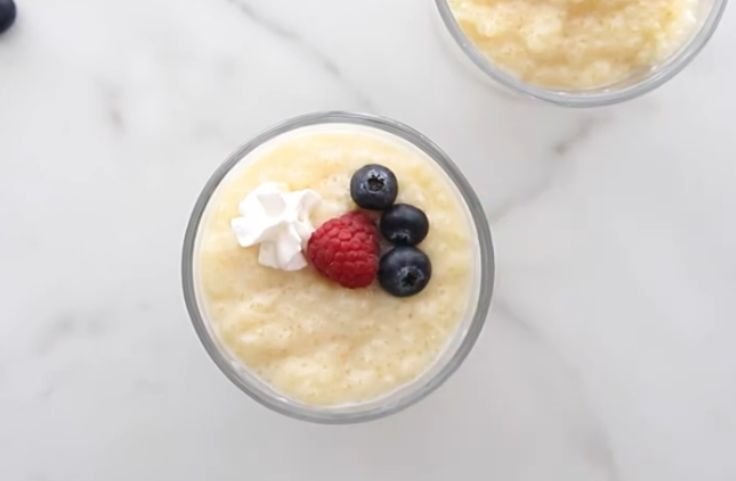Can diabetics eat pudding made with tapioca? This sweet treat can still fit into your diet, with smart swaps, portion control, and blood sugar awareness guiding each creamy spoonful.
Tapioca pudding is a classic dessert loved for its creamy texture and mild sweetness.
Made from tapioca pearls, which come from the cassava root, this pudding brings comfort and nostalgia to many.
It can be served warm or chilled, with toppings like fresh fruit or whipped cream adding extra flavor.
While its taste and versatility make it a favorite at family tables and festive events, those with diabetes face important concerns.
The high carbohydrate and sugar content in traditional recipes can impact blood sugar levels.
This raises the question of whether tapioca pudding is suitable for diabetics.
This guide explains the nutritional details, possible alternatives, and mindful ways to enjoy tapioca pudding while maintaining health.
Related: How Good is Tapioca Pudding for You?
Table of Contents
- Understanding the Glycemic Impact of Tapioca Pudding
- Can Diabetics Eat Tapioca Pudding?
- Diabetic-Friendly Alternatives and Modifications
- Practical Tips for Safe Consumption
- Alternatives to Tapioca Pudding for Diabetics
- Conclusion
- Frequently Asked Questions
Understanding the Glycemic Impact of Tapioca Pudding
Tapioca pudding, made from cassava root starch, is rich in carbohydrates but low in protein and fat, making it highly energy-dense.
Its glycemic index (GI) typically falls between 70 and 80, meaning it raises blood sugar rapidly.
A half-cup serving contains around 30 grams of carbs, which can significantly impact glucose control, especially for individuals with diabetes.
High-GI foods like tapioca pudding can trigger sharp insulin responses, leading to fluctuations that may be difficult to manage.
For diabetics, both carbohydrate content and glycemic impact must be considered when making dietary choices.
While tapioca pudding can still be enjoyed occasionally, portion control is key.
Pairing it with fiber-rich ingredients or choosing lower-GI alternatives can help balance its effects.
Understanding the glycemic impact of tapioca pudding enables healthier meal planning and helps individuals, particularly those managing diabetes, maintain more stable blood sugar levels throughout the day.
Related: Is Tapioca Pudding Gluten-Free?
Can Diabetics Eat Tapioca Pudding?
If you have diabetes, you know how important it is to balance taste with health.
Tapioca pudding can fit into your diet, but you need to make mindful choices.
Watch the sugar content
Most traditional tapioca pudding recipes use a lot of sugar, which can spike blood sugar quickly. If you prepare it at home, you control what goes in.
Swap refined sugar for low-glycemic sweeteners like stevia or erythritol to keep sweetness without affecting your glucose levels as much.
This way, you enjoy dessert while reducing the risks of unwanted blood sugar spikes.
Keep portions small
Even when modified, tapioca pudding is carbohydrate-rich. Stick to a small serving so it does not overload your system.
Pair it with fiber-rich fruit or a protein source like Greek yogurt to slow down sugar absorption.
This pairing helps maintain steady blood sugar while still letting you enjoy the creamy texture of this dessert.
Add healthier ingredients
Adjusting the base can make tapioca pudding more diabetes-friendly.
Instead of whole milk or cream, try almond milk, soy milk, or oat milk for fewer calories and better balance.
You can also add chia seeds, flaxseeds, or nuts for extra fiber and nutrients.
These additions make the pudding more filling and slow digestion, helping to keep glucose stable.
Fit it into your meal plan
Tapioca pudding is not off-limits, but it should be a mindful addition rather than a daily choice.
Consider it part of your overall meal instead of a standalone snack.
By keeping track of your carbohydrate intake throughout the day, you can enjoy this dessert without disrupting your diet.
Consult your dietitian for tailored advice that matches your health goals.
Related Posts
How Healthy Is Tapioca Pudding?
Tapioca Sabudana: How to Make It
Best Toppings for Your Chocolate Tapioca Pudding
How to Make Tapioca Tortillas with Few Ingredients
Best Tips for Perfect Mango Tapioca Pudding Every Time
Diabetic-Friendly Alternatives and Modifications
Tapioca pudding may seem off-limits for people managing diabetes, but small, thoughtful changes make it a safer option.
By choosing healthier sweeteners, milk substitutes, and controlling portions, you can enjoy pudding without compromising blood sugar control.
Use Sugar Alternatives Instead of Regular Sugar
Traditional sugar can cause dangerous spikes in blood glucose, but diabetic-friendly substitutes like stevia, erythritol, and monk fruit provide sweetness without excess carbohydrates.
These alternatives maintain flavor, contain little to no calories, and help regulate sugar levels, making pudding safer and more balanced.
Opt for Unsweetened Milk or Milk Alternatives
Regular cow’s milk often contains natural sugars that may increase carbohydrate content.
Instead, choose unsweetened almond milk, coconut milk, or other plant-based options.
These alternatives cut hidden sugars, add creaminess, and introduce new flavors while reducing overall impact on blood sugar management.
Related: What is in Tapioca Pudding?
Practice Portion Control for Better Blood Sugar Balance
Even with healthier ingredients, overindulgence can disrupt diabetic control. Smaller serving sizes ensure fewer carbohydrates are consumed.
Enjoying pudding in moderation, alongside fiber- or protein-rich foods, helps stabilize blood sugar and allows diabetics to enjoy dessert without unnecessary health risks.
Enhance Flavor with Berries and Nuts
Adding fresh berries or nuts brings extra flavor and texture while boosting nutrients.
Berries offer antioxidants and fiber that aid blood sugar control, while nuts supply healthy fats and protein.
These additions make pudding more satisfying and diabetes-friendly.
Related: Dairy-Free Tapioca Pudding
Practical Tips for Safe Consumption
Tapioca pudding can be part of your diet if you manage diabetes carefully. ‘
With the right strategies, you can enjoy its creamy texture and mild sweetness while keeping blood sugar levels in check.
Pair Tapioca Pudding with Protein or Healthy Fats
Combine your pudding with nuts, Greek yogurt, or chia seeds to slow carbohydrate absorption.
This helps lower the glycemic impact, keeps you full longer, and balances the nutritional profile of the dessert for safer enjoyment.
Monitor Blood Sugar Levels After Eating
Check your glucose within two hours after eating tapioca pudding.
Tracking responses over time in a food diary helps you understand how your body reacts and guides future portion sizes or recipe adjustments.
Choose the Right Timing for Consumption
Eating tapioca pudding when blood sugar is more stable, such as an afternoon snack, can reduce spikes.
Avoid late-night servings and focus on smaller portions for better glucose management.
Practice Mindful Portion Control
Serving smaller amounts allows you to enjoy the dessert without overwhelming your system.
Moderation ensures tapioca pudding fits into a balanced diet while supporting overall health goals.
Related: How to Make Vegan Tapioca Pudding
Alternatives to Tapioca Pudding for Diabetics
Finding a dessert that satisfies your sweet cravings while keeping blood sugar in check can be challenging.
Luckily, some options give you creamy textures and enjoyable flavors without the high carbohydrate load of tapioca pudding.
Chia Seed Pudding: A Fiber-Rich Option
Chia seeds absorb liquid and form a gel-like texture similar to tapioca.
Mix them with unsweetened almond milk and vanilla extract for a dessert low in carbohydrates that supports stable blood sugar and adds fiber for digestive health.
Unsweetened Greek Yogurt: Creamy and Protein-Packed
Greek yogurt offers a smooth texture and tangy flavor. Pair it with low-sugar fruits like berries for a nutritious dessert rich in protein and probiotics, supporting digestion and glucose management.
Coconut Milk Pudding: Healthy Fats for Sweet Cravings
Use coconut milk with low-carb thickeners like gelatin or agar-agar to create a creamy dessert. Add vanilla or spices for flavor without raising blood sugar, making it a safe treat.
Almond Flour-Based Desserts: Low-Carb Satisfying Treats
Almond flour cookies or cakes are lower in carbs than traditional options.
Sweeten with stevia or erythritol to enjoy a dessert that keeps blood sugar stable while satisfying cravings.
Conclusion
In managing diabetes, you can enjoy tapioca pudding if you approach it carefully.
Being mindful of portion sizes is key to preventing blood sugar spikes.
Pairing the pudding with protein or healthy fats can slow sugar absorption and help you feel full.
Choosing sugar substitutes like stevia or erythritol keeps the glycemic impact low while maintaining sweetness.
Adding nutrient-rich ingredients such as chia seeds or almond milk can boost the pudding’s overall nutritional value.
Monitoring your blood sugar after eating helps you understand how it affects you personally.
With these strategies, tapioca pudding can fit into a balanced diet, letting you enjoy a sweet treat without compromising your health or dietary goals.
Frequently Asked Questions
Can people with diabetes eat tapioca pudding?
Yes, diabetics can enjoy tapioca pudding in moderation by controlling portions, using low-glycemic sweeteners, and pairing it with protein or fiber to manage blood sugar levels.
How can I make tapioca pudding safe for diabetes?
Use sugar substitutes like stevia or erythritol, opt for unsweetened milk or plant-based alternatives, and include chia seeds or nuts to boost fiber and nutrients.
What portion size of tapioca pudding is safe for diabetics?
Keep servings small, around half a cup or less, and combine with protein or fiber-rich foods to slow carbohydrate absorption and prevent blood sugar spikes.
Are there diabetic-friendly alternatives to tapioca pudding?
Yes, chia seed pudding, unsweetened Greek yogurt with berries, coconut milk pudding, and almond flour-based desserts offer similar textures and flavors without high carbohydrate impact.
References

Chimeremeze Emeh is a writer and researcher passionate about Africa’s most transformative root crop—cassava. Through his work at cassavavaluechain.com, he explores the entire cassava industry, from cultivation and processing to its diverse applications in food, health, and industrial use.
He also writes for palmoilpalm.com, where he shares his extensive experience and deep-rooted knowledge of palm oil, covering red palm oil, palm kernel oil, and refined products. His work there reflects his lifelong connection to agriculture and his commitment to promoting sustainable value chains in Africa.
Driven by curiosity and purpose, Chimeremeze aims to shed light on how cassava continues to empower communities, strengthen food systems, and link traditional farming wisdom with modern innovation.

